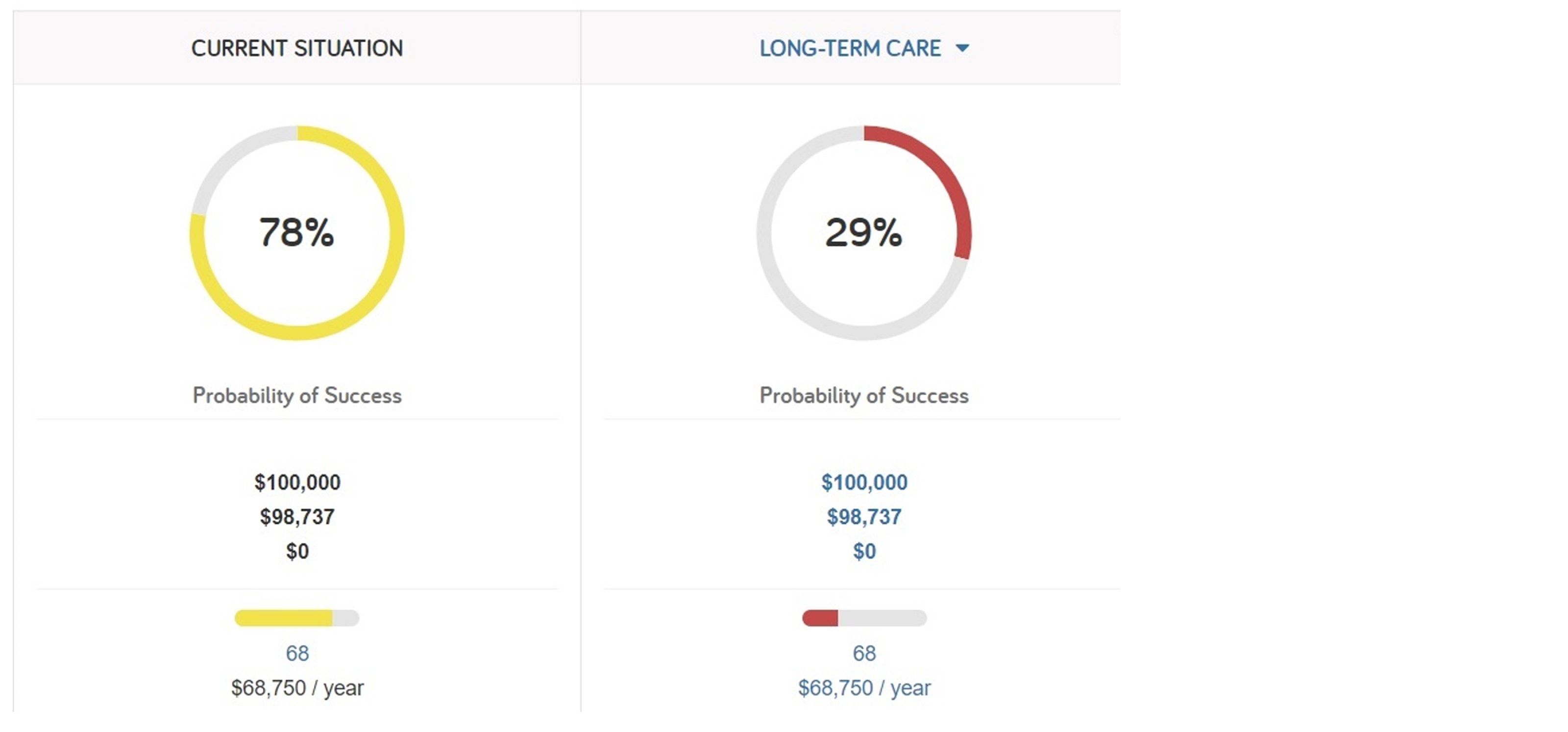A Woman’s Guide to Long-Term Care
Who needs long-term care insurance … and who might be able to do without it?


Women face unique challenges as they age. According to the Population Reference Bureau, a Washington based think tank, women live about seven years more than men. Living longer means planning for a longer retirement. That sounds good, but a longer retirement increases the odds of needing long-term care. A 2004 AARP study found more than 70% of nursing home residents were women.
Living longer also increases the odds of going it alone, as living longer may mean outliving a spouse. According to the Joint Center for Housing Studies of Harvard University, “In 2018 women comprised 74% of solo households age 80 and over.”
For these reasons, women should think about how to plan for long-term care.
From just $107.88 $24.99 for Kiplinger Personal Finance
Become a smarter, better informed investor. Subscribe from just $107.88 $24.99, plus get up to 4 Special Issues

Sign up for Kiplinger’s Free Newsletters
Profit and prosper with the best of expert advice on investing, taxes, retirement, personal finance and more - straight to your e-mail.
Profit and prosper with the best of expert advice - straight to your e-mail.
Ability to pay
Long-term care is costly. The average private room at a long-term care facility is over $13K a month in my home state of Connecticut, according to Genworth’s Cost of Care Survey. Florida is a little cheaper. In the Naples area a private room is about $11K a month.
Of course, there are ways to keep the cost down, like paying for care at home. Home health care is about $5K a month in Naples, Fla. (Genworth 2020 figures). Multiply these numbers by 1.44 years – the average duration of care for women, according to the study – and these numbers can get big fast.
Medicare and Medicaid
Government programs such as Medicare and Medicaid are tricky. Medicare may cover some long-term care expenses, but only for the first 100 days. Medicare does not pay for custodial care – at home long-term care. Medicaid pays for long-term care, but you must qualify financially. Also, most long-term care facilities in my experience only have a set number of Medicaid beds available.
Spending down an estate to qualify for Medicaid is one way to pay for long-term care, but it’s not ideal in my opinion.
The risk the facility you want is not available for Medicaid recipients looms large. Also, to qualify for Medicaid may leave you financially destitute, not ideal after a lifetime of working. Finally, the rules for Medicaid can change. For some, Medicaid is the only option. For others, who have time on their side and the resources available, now is the time to start planning.
Run the Retirement Projections
The first step when mapping out a road trip on a GPS is to enter in your starting and destination point. It’s the same with retirement and long-term care planning. When I take on a new client, we always review the retirement projections. We start with an ideal scenario. This may mean both spouses live long happy lives. Or it could mean no long-term care is needed. Then I play a series of “what-if” scenarios. What-if the husband passes early? How does that impact their retirement? What if a female client lives to 100? Will she have enough to live on? What-if a single woman needs long-term care for dementia? Alzheimer’s and dementia can last for years, wreaking havoc on a retiree’s nest egg. I always stress test the ideal scenario.
Below is one example. In the base or ideal scenario, the client had a modest retirement success rate of 78% out of 100%. The higher the success rate, the better the chance the client does not run out of money. However, the odds drastically decrease when we plug in a long-term care expense for two years at her age 86.

Planning for long-term care
The outputs drive the recommendations. If a female client has a high retirement success rate – even with the long-term care expenses added into the analysis – then she may want to self-insure her future long-term care expenses. Self-insuring can mean setting up a designated long-term care investment account solely to be used for future long-term care expenses. This account can be a brokerage account or IRA or health savings account if available. Long-term care costs have increased by about 3%-5% over the years, a diversified portfolio is a smart way to keep pace with inflation.
If a female client has a modest degree of retirement success, like in the example above, the planning may be slightly different. The woman in this example may want to decrease current expenses to save more for the future. She may also want to review long-term care insurance. I may recommend in this scenario some combination of both – self-insuring and purchasing a small long-term care policy. The long-term care insurance is a backstop – preventing her from completely depleting her nest egg in the event of a long, protracted illness.
Some states also offer “partnership plans.” A partnership long-term care plan is a private insurance policy with a special perk. The plan allows an individual to keep some of the nest egg and still qualify for Medicaid. For example, if a partnership long-term care plan pays $300K in long-term care benefits, then $300K of personal investments or cash may be excluded from the Medicaid qualifying calculation. This is helpful if you do end up needing Medicaid to pay for long-term care.
Partnership plans have specific policy provisions like inflation protection. It’s best to seek help from a qualified agent familiar with partnership plans.
Other planning implications
Women can also consider delaying taking Social Security till age 70. If women live longer, the extra benefits accrued by waiting can help with long-term care. Women with a higher-earning husband may want to encourage the higher-earning spouse to delay until age 70 if appropriate. When the higher-earning spouse passes away, the widow can step into the higher benefit.
The average break-even age is generally around 77-83 for Social Security. If an individual can live longer than 83, the more dollars and sense it makes to delay collecting till age 70.
Finally, getting the right estate documents in order is a must. Women – and men – should have a power of attorney (POA). A POA gives a trusted individual the ability to write checks and send money to pay for long-term care. Women and men should also have a “trusted contact” on all their investment accounts. A trusted contact cannot transact money but is notified in the event of suspected elder abuse or fraud.
The moral of the story is to start planning! Women especially need to think about the impact a longer life can have on their retirement. Start with running the retirement projections. Play the “what-if” scenarios. The more a prospective client procrastinates, the fewer options are generally available. A change in health could prevent someone from qualifying for long-term care insurance. Delaying saving for a future long-term care expense can mean less growth on the investment.
When it comes to planning, patience is often not a virtue. Delaying or kicking the can down the road may prove costly.
For more information or to discuss your retirement and long-term care, please send me an email at maloi@sfr1.com.
Further reading: 3 Ways to Pay for Long-term Care
Investment advisory and financial planning services are offered through Summit Financial LLC, an SEC Registered Investment Adviser, 4 Campus Drive, Parsippany, NJ 07054. Tel. 973-285-3600 Fax. 973-285-3666. This material is for your information and guidance and is not intended as legal or tax advice. Clients should make all decisions regarding the tax and legal implications of their investments and plans after consulting with their independent tax or legal advisers. Individual investor portfolios must be constructed based on the individual’s financial resources, investment goals, risk tolerance, investment time horizon, tax situation and other relevant factors. Past performance is not a guarantee of future results. The views and opinions expressed in this article are solely those of the author and should not be attributed to Summit Financial LLC. Links to third-party websites are provided for your convenience and informational purposes only. Summit is not responsible for the information contained on third-party websites. The Summit financial planning design team admitted attorneys and/or CPAs, who act exclusively in a non-representative capacity with respect to Summit’s clients. Neither they nor Summit provide tax or legal advice to clients. Any tax statements contained herein were not intended or written to be used, and cannot be used, for the purpose of avoiding U.S. federal, state or local taxes.
Profit and prosper with the best of Kiplinger's advice on investing, taxes, retirement, personal finance and much more. Delivered daily. Enter your email in the box and click Sign Me Up.

Michael Aloi is a CERTIFIED FINANCIAL PLANNER™ Practitioner and Accredited Wealth Management Advisor℠ with Summit Financial, LLC. With 21 years of experience, Michael specializes in working with executives, professionals and retirees. Since he joined Summit Financial, LLC, Michael has built a process that emphasizes the integration of various facets of financial planning. Supported by a team of in-house estate and income tax specialists, Michael offers his clients coordinated solutions to scattered problems.
-
 Dow Adds 646 Points, Hits New Highs: Stock Market Today
Dow Adds 646 Points, Hits New Highs: Stock Market TodayIt was "boom" for the Dow but "bust" for the Nasdaq following a December Fed meeting that was less hawkish than expected.
-
 5 Types of Gifts the IRS Won’t Tax: Even If They’re Big
5 Types of Gifts the IRS Won’t Tax: Even If They’re BigGift Tax Several categories of gifts don’t count toward annual gift tax limits. Here's what you need to know.
-
 The 'Scrooge' Strategy: How to Turn Your Old Junk Into a Tax Deduction
The 'Scrooge' Strategy: How to Turn Your Old Junk Into a Tax DeductionTax Deductions We break down the IRS rules for non-cash charitable contributions. Plus, here's a handy checklist before you donate to charity this year.
-
 I'm a Tax Attorney: These Are the Year-End Tax Moves You Can't Afford to Miss
I'm a Tax Attorney: These Are the Year-End Tax Moves You Can't Afford to MissDon't miss out on this prime time to maximize contributions to your retirement accounts, do Roth conversions and capture investment gains.
-
 I'm an Investment Adviser: This Is the Tax Diversification Strategy You Need for Your Retirement Income
I'm an Investment Adviser: This Is the Tax Diversification Strategy You Need for Your Retirement IncomeSpreading savings across three "tax buckets" — pretax, Roth and taxable — can help give retirees the flexibility to control when and how much taxes they pay.
-
 Could an Annuity Be Your Retirement Safety Net? 4 Key Considerations
Could an Annuity Be Your Retirement Safety Net? 4 Key ConsiderationsMore people are considering annuities to achieve tax-deferred growth and guaranteed income, but deciding if they are right for you depends on these key factors.
-
 I'm a Financial Pro: Older Taxpayers Really Won't Want to Miss Out on This Hefty (Temporary) Tax Break
I'm a Financial Pro: Older Taxpayers Really Won't Want to Miss Out on This Hefty (Temporary) Tax BreakIf you're age 65 or older, you can claim a "bonus" tax deduction of up to $6,000 through 2028 that can be stacked on top of other deductions.
-
 Meet the World's Unluckiest — Not to Mention Entitled — Porch Pirate
Meet the World's Unluckiest — Not to Mention Entitled — Porch PirateThis teen swiped a booby-trapped package that showered him with glitter, and then he hurt his wrist while fleeing. This is why no lawyer will represent him.
-
 Smart Business: How Community Engagement Can Help Fuel Growth
Smart Business: How Community Engagement Can Help Fuel GrowthAs a financial professional, you can strengthen your brand while making a difference in your community. See how these pros turned community spirit into growth.
-
 In 2026, the Human Touch Will Be the Differentiator for Financial Advisers
In 2026, the Human Touch Will Be the Differentiator for Financial AdvisersAdvisers who leverage innovative technology to streamline tasks and combat a talent shortage can then prioritize the irreplaceable human touch and empathy.
-
 How Financial Advisers Can Deliver a True Family Office Experience
How Financial Advisers Can Deliver a True Family Office ExperienceThe family office model is no longer just for the ultra-wealthy. Advisory firms will need to ensure they have the talent and the tech to serve their clients.